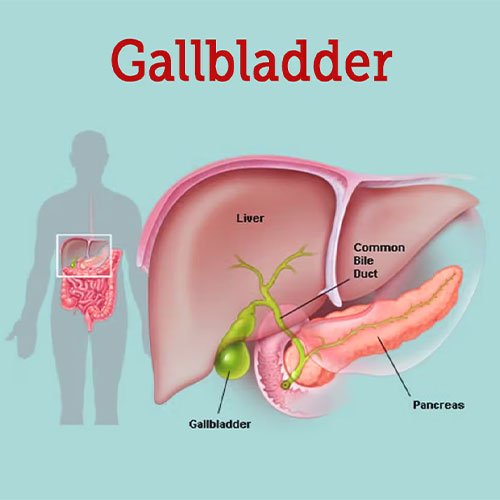
Gall Bladder
Gall Bladder
The gallbladder is a small, pear-shaped organ located beneath the liver. It plays a key role in the digestive process by storing bile, a digestive fluid produced by the liver. Bile helps break down fats in the small intestine, allowing the body to absorb essential nutrients more effectively. However, various conditions can affect the gallbladder, leading to symptoms and potentially requiring treatment. Here’s an overview of the gallbladder, common issues, and treatment options.
Gallbladder issues can range from minor discomfort to severe pain and complications. Early diagnosis and treatment, whether through dietary changes, medication, or surgery, can help prevent severe outcomes and improve quality of life. If you experience persistent symptoms, consulting a healthcare professional for diagnosis and treatment is essential.

Gallbladder Conditions
Some of the most common gallbladder-related issues include:
- Gallstones: Solid particles form in the gallbladder due to an imbalance in bile components. These stones can range from tiny grains to larger stones and may block bile ducts, causing pain, infection, or inflammation.
- Cholecystitis: Inflammation of the gallbladder, often caused by gallstones blocking the bile ducts. Acute cholecystitis causes sudden pain, usually in the upper right abdomen, and can lead to fever, nausea, and vomiting.
- Biliary Colic: Caused by intermittent obstruction of the bile duct by gallstones, leading to episodes of abdominal pain, especially after meals high in fat.
- Gallbladder Cancer: Though rare, gallbladder cancer can be aggressive. Its symptoms are similar to other gallbladder conditions, making it challenging to detect early.
Symptoms of Gallbladder Issues
Symptoms of gallbladder problems may include:
- Severe, sudden pain in the upper right abdomen or the center of the abdomen
- Pain that radiates to the right shoulder or back
- Nausea or vomiting
- Jaundice (yellowing of the skin or eyes)
- Fever and chills
Diagnosis of Gallbladder Problems
Diagnosis often involves:
- Ultrasound: The primary imaging tool used to detect gallstones or inflammation.
- CT Scan or MRI: Advanced imaging methods to examine the gallbladder and nearby organs.
- HIDA Scan (Hepatobiliary Iminodiacetic Acid): A specialized scan that assesses gallbladder function.
- Blood Tests: Used to check for infections or liver enzyme abnormalities.
Treatment Options for Gallbladder Issues
Treatment depends on the specific gallbladder condition and the severity of symptoms.
1. Lifestyle and Dietary Changes
- Dietary Modifications: A diet low in fat and high in fiber can reduce the risk of gallstone formation and alleviate symptoms.
- Hydration: Staying well-hydrated helps maintain bile consistency, reducing the risk of gallstone formation.
2. Medication
- Pain Management: NSAIDs or prescription pain relievers for acute pain.
- Dissolving Gallstones: Medications like ursodeoxycholic acid may help dissolve smaller gallstones over time. However, this treatment is less effective and typically used for people who cannot undergo surgery.
3. Surgery
- Cholecystectomy (Gallbladder Removal): The most common treatment for symptomatic gallstones or chronic gallbladder issues. There are two types of cholecystectomy:
- Laparoscopic Cholecystectomy: Minimally invasive, with faster recovery times and smaller incisions. This is the preferred method.
- Open Cholecystectomy: Requires a larger incision and longer recovery; it’s usually reserved for cases with complications.
- ERCP (Endoscopic Retrograde Cholangiopancreatography): A procedure used to remove gallstones from the bile ducts or relieve obstructions.
4. Alternative Therapies
- Some individuals opt for natural remedies or herbal treatments, such as milk thistle or artichoke, to support liver and gallbladder function. However, these should be used cautiously and under medical guidance, as their efficacy is not well-established.
Post-Surgery and Long-Term Outlook
Living without a gallbladder is possible, as the liver continues to produce bile. However, bile flows continuously into the intestines, sometimes leading to digestive issues, particularly with high-fat foods. In most cases, people can adapt to a gallbladder-free life with minor dietary adjustments.
Preventing Gallbladder Problems
While genetics and age can influence gallbladder health, some lifestyle changes can reduce risk:
- Maintain a Healthy Weight: Obesity is a significant risk factor for gallstones.
- Regular Exercise: Physical activity helps regulate bile production and reduces cholesterol levels.
- Balanced Diet: A diet high in fiber, whole grains, fruits, and vegetables, and low in unhealthy fats may reduce the likelihood of gallstones.
